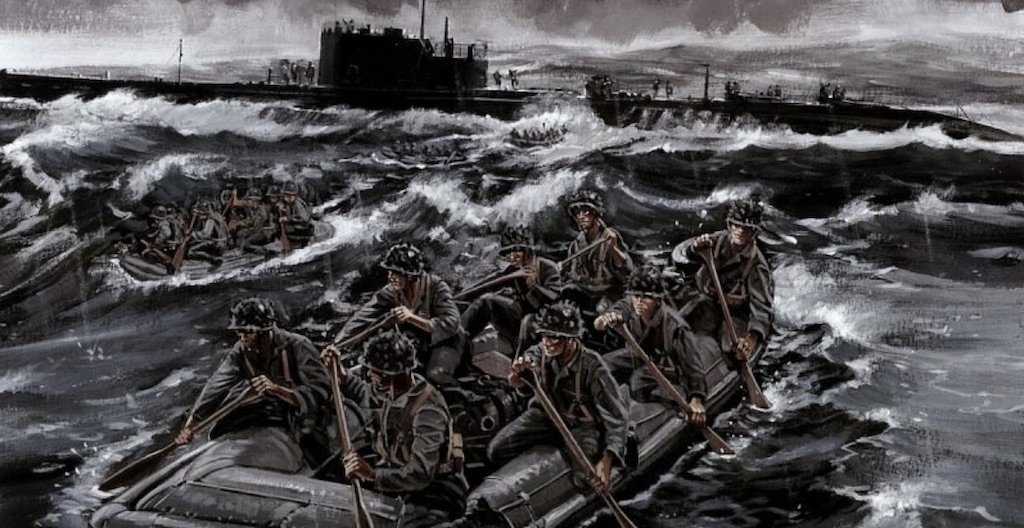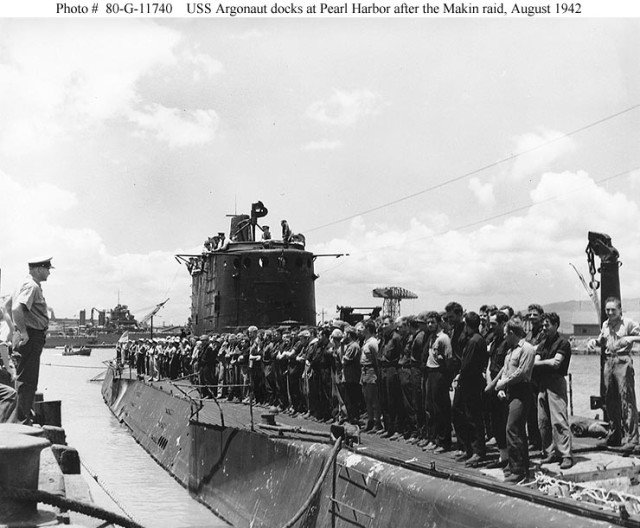How US Marine Raiders Used Submarines to Raid Makin Island During World War II

Artwork depicting Carlson’s Raiders launching from submarine to commence their assault against the Japanese. Photo courtesy of War History Online (https://www.warhistoryonline.com/guest-bloggers/the-marine-raid-on-butaritari-the-true-story.html)
At 3:30 a.m. on Aug. 17, 1942, 20 rubber boats carrying 11 Marine Raiders in each from 2nd Raider Battalion, launched from the USS Nautilus S-168 and the USS Argonaut SM-1. The two submarines had traveled for nine days from Pearl Harbor to the Gilbert Islands, a chain of 16 atolls and coral islands located in the South Pacific. Their target was a seaplane base and Japanese garrison on the flat island of Butaritari, formerly known as Makin Island. The submarines parked 500 yards offshore while the Raiders embarked toward the beach following Lt. Col. Evan Carlson — who was described as “an intellectual who loved combat” and had been previously awarded the Navy Cross for repelling more than 100 bandits in Nicaragua despite his element-sized force.
Immediately, Carlson’s Raiders struggled through the strong current, high swells, and relentless wind as their dodgy outboard motors spit through the salty water. Since their gear — including mortars, heavy weapons, and supplies — weren’t tied down to their rubber boats, the waves sloshed and dislodged much of their equipment into the sea before the raid had even started. As they scrambled up the beach undetected, one of the Marine Raiders of Carlson’s infamous “Gung-ho Battalion” had negligently discharged his Browning, erasing the element of surprise.

Carlson sent a situation report over the radio to inform the Nautilus: “Everything lousy.” The boats were stashed under foliage near the beach, and their assault ensued. The submarines provided water superiority, including the destruction of Japanese ships with salvos ordered by Maj. James Roosevelt, President Franklin Delano Roosevelt’s oldest son and a Marine Raider on the mission. The Japanese, however, had aerial superiority with planes that circled overhead flying strafing runs, and threats of the bombers forced the submarines to submerge. As daylight approached, the Marine Raiders ambushed and attacked Japanese positions, killing snipers with their M1 Garand rifles and silencing waves of banzai attacks.
Dean Winters, one of the Raiders, harassed the Japanese with an antitank gun. “A truck was coming down the road, so I hit the deck, braced myself, and fired, hitting the truck in the radiator,” Winters told the Marine Corps Times. “Steam poured out and several Japs tumbled out.” Winters also used the antitank weapon on two seaplanes that landed in the bay. “All of us were firing at them. The smaller one caught fire and burned. The bigger plane was a four-engine seaplane. I remember firing about 20 rounds. It took off, and flames came up on it, and then it went down.”

The intention of the raid on Makin Island was not to occupy but to act as a diversion to draw Japanese troops away from the campaign on Guadalcanal. Carlson and Roosevelt ordered the Marine Raiders to exfiltrate toward the beach and rendezvous back with the submarines offshore. Communications, however, were being jammed by the Japanese, and the motors to the boats proved to be incapable of overcoming the 15 foot waves.
“In the evening when we were supposed to evacuate, we got into our boat and tried to get it out, but the surf was too high,” Winters said. “The boat kept tipping over backwards, and we lost everything. To keep from drowning, I took all my clothes off. The last thing we tried to do was swim out to the reef with a long rope and tow the boat with the rope.”

Seven boats carrying 93 Marine Raiders miraculously made it through the surf zone to reach the USS Nautilus and USS Argonaut. Carlson’s situation on the beach with 120 remaining Marines grew dire, all exhausted from repeated attempts through the crashing waves. Carlson and Roosevelt huddled together and formed a plan — lacking ammunition and weapons — to send a surrender note to a lone Japanese sailor to deliver to his commander, but the sailor was shot during the confusion by an American unaware of their intentions.
Further rescue attempts were made, including a rescue boat dispatched from one of the submarines, but it too had been sunk by a Japanese aircraft strafing run. The rest of the Marine Raiders who were unwilling to be captured made their final attempt at contacting with their sub at the entrance of Makin Lagoon. Lt. Charlie Lamb led a small group to overtake an enemy sloop, avoided gunfire from point-blank range, tossed a hand grenade through the port, and neutralized the Japanese guard. In addition to the action that awarded him the Navy Cross, Lamb used the three remaining rubber boats and attached two native canoes to construct a makeshift raft. Although they had two motors, the 72 Marine Raiders slowly floated 4 miles out to sea where they were picked up, ending the bloody siege.
If Carlson’s plan to surrender had materialized, they, too, would have experienced a similar fate of the Marine Raiders who hadn’t made it off the island. When they returned to Pearl Harbor aboard the submarines, 18 were deemed killed in action while 13 Marine Raiders were declared missing in action, having disappeared without a trace. It took Army investigators some 50 years to find and recover the missing bodies, and it was later determined that at least nine Marine Raiders had survived for 12 days on the run with assistance of the island natives before they were captured on Aug. 30, 1942, and later executed.

Matt Fratus is a history staff writer for Coffee or Die. He prides himself on uncovering the most fascinating tales of history by sharing them through any means of engaging storytelling. He writes for his micro-blog @LateNightHistory on Instagram, where he shares the story behind the image. He is also the host of the Late Night History podcast. When not writing about history, Matt enjoys volunteering for One More Wave and rooting for Boston sports teams.
BRCC and Bad Moon Print Press team up for an exclusive, limited-edition T-shirt design!
BRCC partners with Team Room Design for an exclusive T-shirt release!
Thirty Seconds Out has partnered with BRCC for an exclusive shirt design invoking the God of Winter.
Lucas O'Hara of Grizzly Forge has teamed up with BRCC for a badass, exclusive Shirt Club T-shirt design featuring his most popular knife and tiomahawk.
Coffee or Die sits down with one of the graphic designers behind Black Rifle Coffee's signature look and vibe.
Biden will award the Medal of Honor to a Vietnam War Army helicopter pilot who risked his life to save a reconnaissance team from almost certain death.
Ever wonder how much Jack Mandaville would f*ck sh*t up if he went back in time? The American Revolution didn't even see him coming.
A nearly 200-year-old West Point time capsule that at first appeared to yield little more than dust contains hidden treasure, the US Military Academy said.












